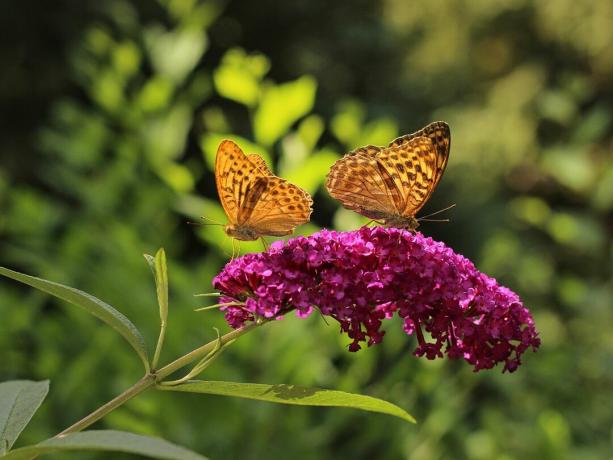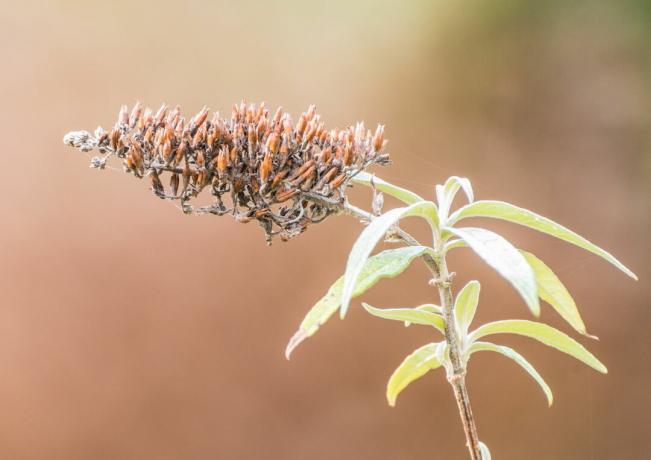The summer lilac, also called butterfly bush or butterfly bush, is very popular in German gardens. These colorful flowering shrubs attract butterflies with their nectar. We will explain how to cut summer lilac correctly and which cutting mistakes to avoid.

The once exotic summer lilac (Buddleja davidii) already conquered. Its success is due to the abundance of flowers that attract butterflies in droves. In order for the shrub to bloom again and again every year, a pruning is required from time to time. Although this is not absolutely necessary, it can encourage lazy specimens to make new efforts. In addition, butterfly bushes grow very luxuriantly. In order to keep them smaller, regular pruning is therefore essential. A rejuvenation cut works wonders, especially with bald summer lilacs.
Since butterfly bushes have a strong need to spread, it makes sense to remove faded flowers in good time.
When is the summer lilac cut?
- In late winter or early spring: pruning for rejuvenation
Prune your buddleia in late winter or early spring. At this point the lilacs are not in the sap and no birds or other creatures nest in the branches. A cut in February on a frost-free day is optimal. In late winter you can also radically rejuvenate your summer lilac and plant it on sticks.
- In autumn: possibly shorten
You can also prune your butterfly bushes in autumn after they have bloomed. However, you should not proceed as radically as with the winter cut. So you should only make small interventions, for example if the shrub needs to be shortened a little.
- In late summer and autumn: remove faded flowers
It is important to remove faded flowers in late summer and autumn. The flowering time of the plant is between July and September. Butterfly bushes produce copious amounts of seeds - fail to prune off the dead flowers and you'll soon have lilacs everywhere.

Instructions on how to properly cut the buddleia
Butterfly bushes are very fast-growing and extremely pruning-tolerant. So you can't go far wrong with a pruning. Even if you want to go more radical, you don't have to give up the flowers that year. In any case, these only appear on the one-year-old shoots, which only develop after the cut.
- Rejuvenation: Buddleia can be pruned radically without hesitation - even annually. Leave the last 20 to 30 centimeters of the plant and always cut just above a bud or a leaf axil. It is essential that you use sharp and clean tools so that there are no entry points for pathogens and the wounds can heal quickly. You should always cut at an oblique angle so that the water does not stand on the cutting edge.
- Cut off faded flowers: Once the flowers have faded, it's worth removing the bud sites before seeds set. Otherwise, it can happen that the butterfly bush spreads quickly in and around the garden. The young seedlings are quickly removed again, but you can save yourself this work. Simply cut back the withered inflorescences to the nearest leaf axil. If you have removed the faded flowers in time, you can put them in the compost without worrying. However, if ovules are already present, you should better choose household waste for disposal.
The butterfly bush or summer lilac is considered invasive due to its ambitious tendency to spread in Europe. The exotic plant does not stick to garden fences, but instead invades the landscape, displacing native species in the process. But the shrub should not be condemned. The plant was given the name "butterfly bush" because it is a valuable food plant for butterflies and bumblebees due to the long flowering period and the abundance of flowers. So butterfly bushes definitely have added value for the insects. Nevertheless, it is advisable to prevent uncontrolled spread, for example by cutting off the withered flowers. There are also sterile varieties, but these are also worthless for insects.

Of course, there are numerous other food plants for insects. If you would like to do something good for the winged pollinators, you will find a selection here insect friendly plants. But you can also use insect-friendly seed mixtures such as the Plantura butterfly meeting To fall back on. This offers butterflies and caterpillars a rich supply of food.



